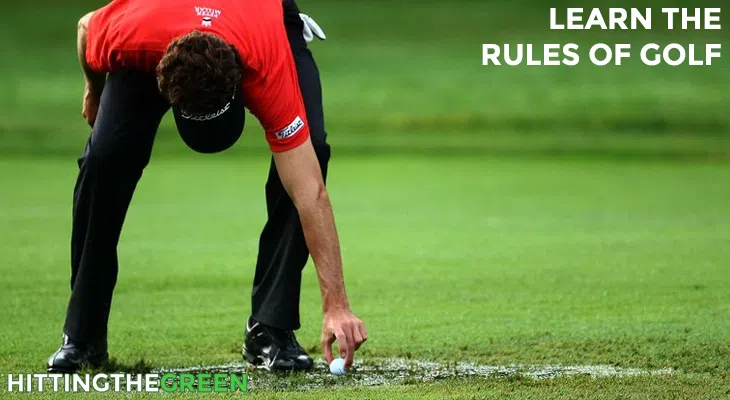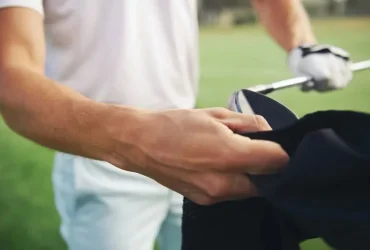Common Golf Rules

Here are a few of the USGA’s most common rules of golf. Of course, rules do change, so if there’s a question, check with the USGA or the R&A (UK) for more in depth Golf Rules and explanation.
Rules During Match and Stroke Play
- Be sure to mark your ball for later identification. Any ball that can’t be identified is lost.
- If a ball becomes unfit for play, it can be replaced on the hole where this happened, or between holes. There is no penalty for this.
- No one may have more than fourteen clubs.
- It’s not okay to use any kind of device or equipment to measure conditions or distance, or to help you get a better grip.
- Never ask anyone except your caddy or partner for advice. Likewise, you should never give anyone other than your partner advice.
- You may practice swing during a hole, but don’t play a practice stroke. If you’re between holes, it’s acceptable to practice putt and chip near or on the putting green of the hole last played. You can also do this on the tee of the next hole. However, you can’t practice from a hazard.
- Avoid delay when playing.
Rules Regarding the Order of Play
- On the first tee, the honor of playing first will be determined by the order of a draw, or by lot.
- The ball furthest from the hole is always played first in match play. The winner of the hole will tee off first at the next hole. Anyone who plays out of turn at any point may be required to replay by his or her opponent.
- The ball further from the hole is also player first in stroke play. However, the person who tees off first at the next hole is usually the competitor with the lowest score. There’s no penalty for playing out of turn.
- Players in four ball competitions can play in the order they prefer.
Rules About the Teeing Ground
- Tee off within two club lengths behind the tee markers’ front edges
- Anyone teeing off outside this area in match play may be required to replay the stroke by their opponent, though there’s no penalty. In stroke play, teeing off outside this area incurs a two stroke penalty, and must replay the stroke from the proper location.
Rules Regarding Ball Play
- Always play the ball as it lies, and never touch it, unless a specific rule permits you to do so.
- Play the course the way you find it. This means never attempting to improve your lie, your line of play, the area you’re intending to swing in, or any extension of your line of play beyond the hole. You may not move anything, bend or break immovable objects or modify the course beyond taking your stance and making your swing. This includes pressing down vegetation or other objects.
- Don’t build your stance.
- If your ball is in a water hazard or bunker, don’t touch the water or the ground before the downswing.
- Always strike the ball with the clubhead, instead of scraping or pushing it. If your club hits the ball multiple times in a single stroke, the stroke is counted, and a penalty stroke is added.
- Playing a wrong ball anywhere except a hazard in match play will cause you to lose the hole. If you are in stroke play, you’ll incur a two stroke penalty. Then, play the right ball.
Rules On the Putting Green
- Unless a rule permits, don’t touch the line of your putt.
- It’s acceptable to fix old hole plugs and ball marks on the line, but not spike marks.
- If you want, you may lift and clean your ball on the green. However, it must be placed on the same spot when finished.
- You may not test the surface by rolling a ball or scraping it.
- If a ball played from the putting green hits the flagstick in match play, you lose the hole. In stroke play, a two stroke penalty is incurred.
- Unless your opponent concedes your putt in match play, always hole out.
Rules If the Ball At Rest Moves
- If you, your caddie, or your partner move the ball in a way that’s not permitted by the rules, or if it moves after you’ve addressed it, replace your ball and add a penalty stroke.
- However, if another ball or person moves your ball, it can be replaced without a penalty.
Contents
If the Ball In Motion Is Stopped or Deflected
- If your ball is stopped or deflected by you, your caddie, or your partner while it’s still moving, the hole is lost in match play. If you are in stroke play, you will incur a two stroke penalty. The ball is then played as it lies.
- If your ball is stopped or deflected by anyone else while it’s moving, play it as it lies without a penalty. In match play, however, if your ball is deflected by an opponent or opponent’s caddie, you can either decide to play it as it lies or replay it. If your ball is deflected after a stroke on the putting green in stroke play, you must replay it.
- If your ball is stopped or deflected by another ball (in play and at rest), while it’s moving, you should play it as it lies. In match play, there is no penalty. In stroke play, a two stroke penalty is incurred if both balls were on the green before you made your stroke.
Dropping, Lifting, and Placing
- If a ball that’s about to be lifted will be replaced afterward, mark its position.
- When dropping the ball, hold it at shoulder height, arm’s length away, and drop it. Your posture should be erect, not stooped. Balls to be dropped in a hazard must be dropped and stay in the hazard.
- If any dropped ball hits a player or that player’s partner, their caddie, or their equipment, it should be re-dropped, but there is no penalty.
- If a dropped ball rolls into or out of a hazard, onto a putting green, into a position where there’s interference by a condition from which relief is taken (in case of embedded ball, wrong putting green, abnormal ground conditions or immovable obstructions) it must be redropped. This is also the case if it comes to rest more than two club lengths from where it first hit a part of the course, or nearer the hole than it’s original position. If the ball rolls into one of these positions again once it’s been redropped, place it in the location where it first struck part of the course after being redropped.
- When the original lie of a ball that’s to be replaced has been changed, place it in the nearest lie similar to the original, as long as that is less than one club length nearer the hole. In a bunker, recreate the original lie and place the ball there.
Interference
- If it would assist another player, you may lift your ball.
- If another ball might interfere with your play, or could assist another player, you may have any other ball lifted.
Loose Impediments
- A loose impediment is a natural object that’s not fixed or growing, adhered to the ball, or solidly embedded. Stones and leaves are loose impediments. It’s acceptable to move loose impediments unless they touch or lie in the same hazard as your ball.
- If you move loose impediments that are within a club length of your ball, and this causes the ball to move, it must be replaced. Unless your ball was on the putting green, you will then incur a penalty stroke.
Obstructions
- Obstructions can include man made (artificial) objects, but not artificial objects that define out of bounds, like fence posts or stakes. Immovable artificial objects that are located out of bounds do not count as obstructions.
- Movable obstructions can be moved, no matter where they’re located. If this causes your ball to move, it may be replaced without incurring any penalty.
- If any immovable obstruction interferes with your swing or stance, you may drop it within a club length of the nearest point of relief, but not closer to the hole. This is the case unless your ball is in a water hazard. There’s no relief for intervention on your line of play, unless both the obstruction and your ball are on the green.
- If an immovable obstruction which is not a water hazard causes your ball to be lost, take the same relief, based on the point where the ball entered that obstruction.
Abnormal Ground Conditions
- When your ball is in ground that’s being repaired, casual water, or a hole made by a burrowing animal (except when it’s in a water hazard), you may drop it within a club length of the nearest point of relief. This is not allowed to be closer to the hole. In a hazard drop, drop the ball in the nearest position of the hazard that affords maximum relief and is not nearer the hole. Alternatively, drop your ball at any distance behind the hazard, but with a one stroke penalty. If your ball is on the putting green, place it in the closest position that affords maximum relief, but isn’t closer to the hole.
- When your ball is lost in these conditions (other than a burrowing animal’s hole in a water hazard), take the same relief, based on the point where the ball last crossed the area’s margin.
Water Hazards
- You may decide to play the ball as it lies. Alternatively, under a one stroke penalty, drop the ball at any distance behind the water hazard. Be certain to keep the point at which the original ball crossed the water hazard’s margin directly between the spot where you drop the ball and the hole. You may also decide to replay the shot.
- In lateral water hazards, you may drop the ball within two club lengths of the point where the it last crossed the margin of the hazard or the point on the opposite margin of the hazard at the same distance from the hole. There’s a one stroke penalty for this.



